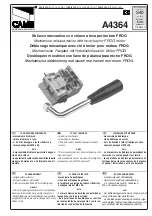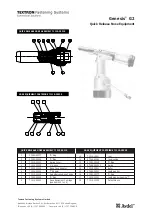
4
When using tools, basic precautions should always be followed, including the
following:
To reduce the risks of electric shock, fire, and injury to persons, read all the
instructions before using the tool.
SPECIFIC SAFETY INSTRUCTIONS
1. The warnings and precautions discussed in this manual cannot cover
all possible conditions and situations that may occur. It must be understood
by the operator that common sense and caution are factors which cannot
be built into this product, but must be supplied by the operator.
2. Obey the manual for the air tool and air compressor used with this tool.
3. Install an in-line shutoff valve to allow immediate control over the air
supply in an emergency, even if a hose is ruptured.
WORK AREA SAFETY
1. Keep the work area clean and well lighted. Cluttered benches and dark
areas increase the risks of electric shock, fire, and injury to per-sons.
2. Keep bystanders, children, and visitors away while operating the tool.
Distractions are able to result in the loss of control of the tool.
PERSONAL SAFETY
1. Stay alert. Watch what you are doing and use common sense when
operating the tool. Do not use the tool while tired or under the influence
of drugs, alcohol, or medication. A moment of inattention while
operating the tool increases the risk of injury to persons.
2. Dress properly. Do not wear loose clothing or jewelry. Contain long
hair. Keep hair, clothing, and gloves away from moving parts. Loose
clothes, jewelry, or long hair increases the risk of injury to persons as a
result of being caught in moving parts.
3. Do not overreach. Keep proper footing and balance at all times. Proper
footing and balance enables better control of the tool in unexpected
situations.
4. Use safety equipment. A dust mask, non-skid safety shoes and a hard
hat must be used for the applicable conditions.
5. Always wear eye protection. Wear ANSI-approved safety goggles.


























